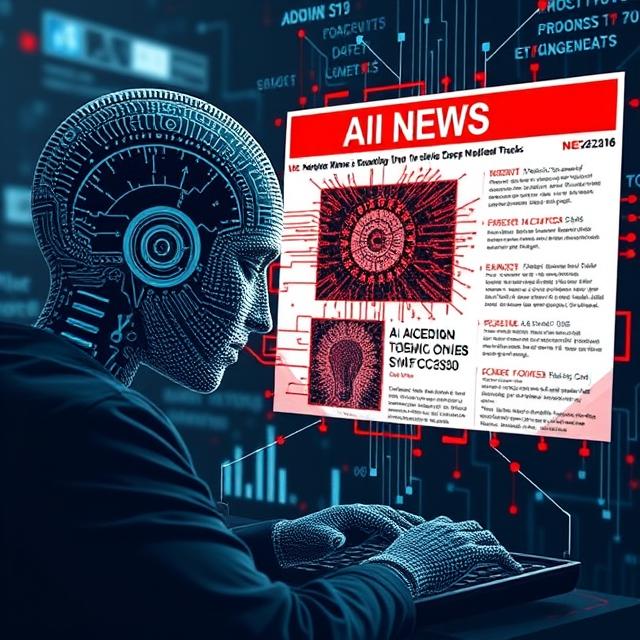The Impact of AI Fake News Detection and Powered Attacks.

AI: A Double-Edged Sword in the Digital Age
Artificial Intelligence (AI) is changing the world rapidly, but its influence is not entirely positive. On one hand, technologies like artificial intelligence fake news detection are helpful in preserving truth and integrity in the media. In contrast, AI-powered attacks are increasingly becoming more prevalent and sophisticated, disruptively building brand new security threats. Therefore, it becomes very pertinent to analyze both the protective side and destainment of AI as it becomes more intelligent.
The Rise of AI in Fake News Detection
In today’s digital age, misinformation spreads faster than ever. The breeding grounds for fake news include social media platforms, blogs, and video-sharing sites. To counter this, developers are working on AI fake news detection systems. These systems analyze the content for factual accuracy, source reliability, linguistic patterns, and emotional tone. The models scan massive amounts of online data to flag or take down misleading content in real-time.
As more and more AI systems are trained on verified sources, their ability to recognize impostor articles has become increasingly reliable. A few models can now determine the authenticity of URLs as well as identify characteristics related to counterfeit accounts. AI fake news detection tools can show incredible speed and scalability in curbing the malignant spread of dangerous disinformation at election time, in times of crisis, or in a pandemic.
Limitations of AI Fake News Tools
Despite being powerful, AI fake news detection is far from perfect. Context becomes very important since the AI still finds it tough to deal with satire, sarcasm, or content that is culturally specific. Real news gets flagged as false sometimes, and disinformation that imitates real content goes undetected. Last but not least, AI’s criteria for determining what is fake could also be strongly influenced by the biases that are within its training data.
To be able to work, they must be constantly updated and checked by human beings, including stakeholders from AI developers, journalism, and ethics. The support of these actors will be paramount in perfectly customizing detection algorithms that will appreciate freedom of speech.
The Threat of AI-Powered Attacks
But while AI is catching fake news, the attackers are making use of AI to cause AI-powered attacks. Such attacks may include deep fake videos and voice impersonations and quite recently have included automated phishing attacks and denial-of-service attacks. AI can do all of those realistic text generation, voice capturing, and online activity impersonation, thereby blurring the line between reality and fiction.
AI is effectively used by hackers to fast assess system vulnerabilities and directly create targeted attacks. Phishing emails generated by AI, for instance, are more believable and personalized, increasing their success rates. AI bots are similarly applied by cybercriminals to go around security and adaptively adjust against any countermeasures. The increasing scale and precision of AI-powered attacks are concerning for governments and institutions as well as for the individuals concerned.

The Impact of AI Fake News Detection and Powered Attacks
Deep Fakes: A New Dimension of Digital Deception
Deepfakes technology, among the most dangerous AI-powered attacks, includes hyper-realistic fake video and audio clips instrumental in swaying the public opinion, humiliating, or creating propaganda. Just a few minutes of a person’s voice or video can be input for the AI to generate something that appears and sounds real but is nothing but a fake.
While some of these deep fakes lightly amuse, others could light fires, impose upon voters, and shake down stock prices. Unfortunately, the rapid improvement of Deepfakes outpaces their detection, and although counter techniques are being developed, the newer versions of Deepfakes technology are becoming harder and harder to detect.
The Need for Global Collaboration
International cooperation is very necessary to comb through the novel risks of the day. There is an urgent need for policymakers, tech companies, and security experts to come together and develop common standards, norms, regulations, and countermeasures. Transparency regarding the whole AI development process, detection of tools, and public awareness campaigns form the essential linchpins in mitigating the risks of AI-powered attack and misinformation.
With heavy reliance on digital platforms, there is a need for a balanced approach that employs AI fake news detection as a shield and protection against the accelerating threat of intelligent cyber-assaults. Education, regulation, and innovation should converge in ensuring a safer digital future.
AI fake news detection and AI-powered attacks are shaping the digital landscape with both protective tools and increasing cyber threats.
The Rise of Self-Learning Programmers and AI Model Parameters
